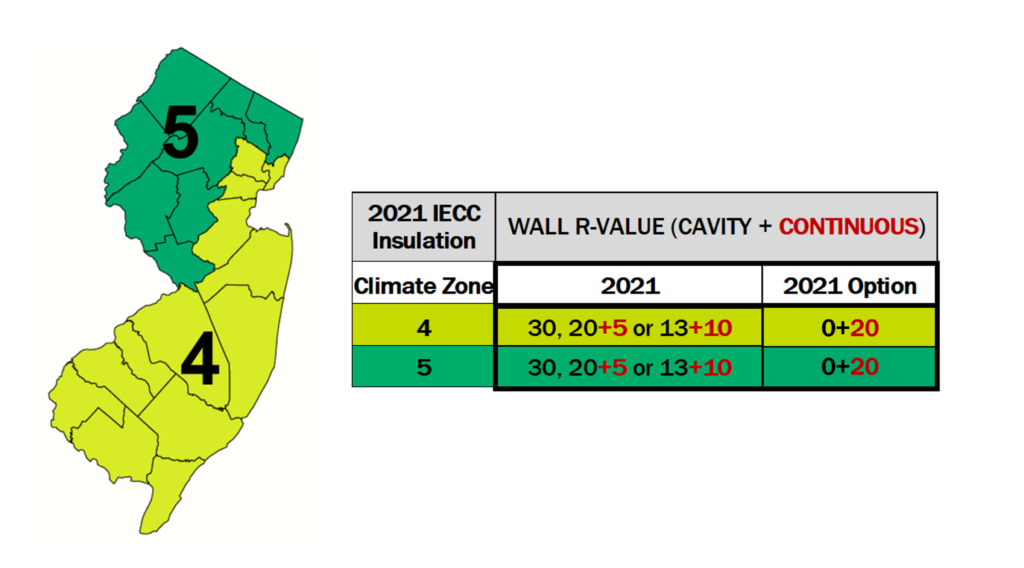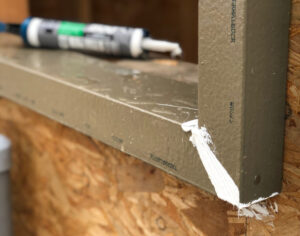Beginning in April 2023, New Jersey began enforcing the 2021 International Energy Conservation Code (IECC) for residential low-rise construction (less than three stories). For the first time, the updated energy code effectively requires continuous insulation for all new construction in the Garden State. Here’s what you need to know and how to meet the new standards for building envelope.
Energy Code Requirements
Although New Jersey is split between Climate Zones four and five, both zones have the same insulation requirements. The requirements for each zone are listed in the chart below.
The new code pushes builders away from cavity insulation by making the requirements difficult to meet. In this case, an R-30 is needed in the cavity. The code introduces continuous insulation (ci) alongside cavity insulation requirements. In this case, the code allows exterior walls must utilize R-20+R-5ci or R-13+R-10ci. Most importantly, the 2021 IECC provides an option for R-20 continuous insulation only.

Builders may choose this option for several reasons, including to minimize materials and for higher performance. Cavity insulation is known to underperform continuous insulation by 15-20% due to the exposed wood or metal studs that act as thermal bridges between the interior and exterior of a home.
It is important to note that municipalities in New Jersey are not permitted to amend the building code in any way.
Homeowner Savings
According to the U.S. Department of Energy, the 2021 IECC will save the average homeowner in New Jersey 16.1% in utility bills annually over the previous code. In other words, new code requirements like continuous insulation, result in net savings in as little as two years. But that’s only when comparing this year’s new construction to last year’s. Because the average home in New Jersey is 53 years old, new construction energy efficiency is magnitudes ahead. In fact, thanks to improvements like continous insulation, the average new construction home is 55% more energy efficient than homes built in 1981. Go a step further and consider that continuous insulation makes 2×4 framing possible, the potential consumer savings is even greater.
Meeting Codes
A variety of continuous insulation solutions exist, but not all materials provide the same benefits. Most of the research on the market compares EPS, XPS, Polyiso and Mineral Wool, because they’ve been readily available on the market. In general, older insulation products such as Styrofoam or Polyiso are good insulators, but trap moisture behind the wall. Alternative materials like mineral wool are plastic-free options but require expensive fasteners, weather barriers, and are heavy and difficult to work with.
One insulation you may not have heard about yet is Neopor® GPS, or graphite polystyrene.
Neopor GPS is included in products like ThermalTight™, a high-performance insulation panel by BRINC Building Products.
ThermalTight™ is a single panel that manages all four control layers of the perfect wall. It has a high long-term R-value, sustainability, ease of installation, and can be used in any climate on walls. It also eliminates an entire trip around the building, thanks to its attached high performance weather resistive barrier. You can learn more about ThermalTight™ here.
See our full comparison of continuous insulations below.
Detailing Windows & Doors
Another concern builders have when using continuous insulation is the proper installation of windows, which essential to avoiding damage to the wall and window. Doing so requires the installation of a ROESE (rough opening extension support element) or “window buck” to properly support the window’s weight and against wind load.

Typical wood bucks are cut from lumber and require thorough waterproofing with expensive flashing tapes. The process is time consuming and takes an experienced builder approximately 45 minutes per opening. Another major drawback is potential warping, rotting, or shrinking around the window—a result of the natural aging and exposure of wood. It is also a potential condensation point and acts as a thermal bridge, which undermines the purpose and effectiveness of continuous insulation.
Because of these problems, many architects and builders have switched to an engineered window buck known as ThermalBuck™.
ThermalBuck™ solves the challenge of installing nail flange windows & doors with exterior insulation by extending the mounting point to create a flush plane for cladding. It also insulates the rough opening, limiting thermal bridging around windows & doors.
Because ThermalBuck™ is coated with a waterproof resin and secured to the rough opening with an air & water barrier sealant and nails, it’s much simpler to install and easier to flash than a wood buck. It is also dimensionally stable and strong, it will not warp, rot, or shrink, and helps to support the weight of the window. ThermalBuck™ outperforms a traditional wood buck and protects the integrity of your window & door installation.
On its launch in 2015 at Greenbuild in Washington, D.C., ThermalBuck™ was awarded “Greenest of the Green Energy Efficient Building Products” by BuildingGreen. In addition to other awards and mentions, it has also been featured by Matt Risinger in “How to Install a Window with Exterior Insulation”.
Bottom Line
New Jersey’s new energy code will result in savings for homebuyers and lead to healthier homebuilding across the state. Since both New Jersey climate zones now require continuous insulation, builders across the state must understand the right products for their projects. No matter what insulation you use, it is important to understand the benefits and drawbacks of current products on the market and incorporate sound building science into each build. With sound product choice and proper installation, builders can also eliminate callbacks from water and moisture damage to walls. For more information or to request product samples, call our expert builders at 1-888-814-2825 or email us at info@brincbp.com.
Additional Resources
New Jersey Division of Codes and Regulations
How to Properly Install Windows with Exterior Insulation (video)
ThermalTight™ Air – Water – Vapor + Thermal
ThermalBuck™ High Performance Window Buck


